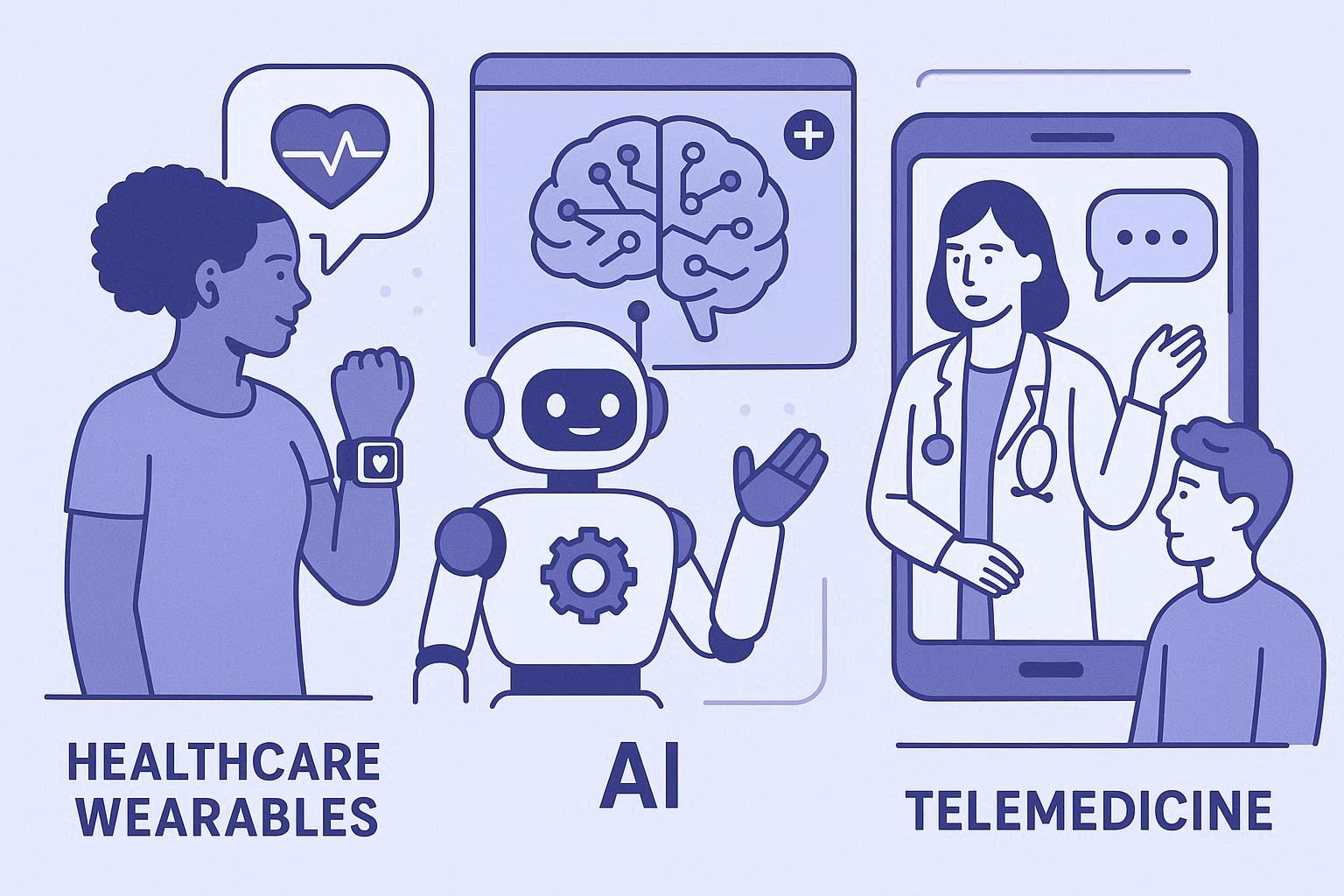The healthcare industry is undergoing a digital revolution. In 2025, technology is not only changing how doctors treat patients but also how individuals manage their own health. From wearable devices that monitor vital signs to artificial intelligence (AI) that analyzes medical data, modern tools are making healthcare more efficient, accessible, and personalized. At the same time, telemedicine is breaking barriers by bringing medical consultations directly into people’s homes.
This article explores how technology is transforming healthcare, the benefits of these innovations, and the challenges they bring.
1. The Digital Transformation of Healthcare
Technology has shifted healthcare from a system focused on treatment to one that emphasizes prevention and patient empowerment. Instead of waiting for illness, people can now monitor their health in real-time and make informed lifestyle choices. Hospitals and clinics are also using digital systems to improve diagnostics, reduce errors, and deliver faster services.
2. Wearable Devices: Health in Your Pocket
Wearables like smartwatches, fitness bands, and biosensors have become part of everyday life. These devices track heart rate, steps, calories, sleep quality, and even oxygen levels. In 2025, the latest wearables go beyond fitness tracking to provide medical-grade data that can alert users to potential health risks. For example:
- Cardiac Monitoring – Smartwatches can detect irregular heartbeats and alert users to seek medical advice.
- Sleep Tracking – Devices monitor sleep cycles and recommend ways to improve rest.
- Blood Sugar Sensors – Non-invasive wearables help people with diabetes manage their glucose levels more effectively.
The convenience of wearables empowers individuals to take proactive steps toward better health and reduces the burden on healthcare systems.
3. Artificial Intelligence in Healthcare
AI is one of the most powerful tools in modern healthcare. It analyzes massive amounts of medical data quickly, helping doctors make more accurate diagnoses and treatment decisions. Applications of AI in 2025 include:
- Medical Imaging – AI detects patterns in X-rays, MRIs, and CT scans that may be missed by the human eye.
- Predictive Analytics – Algorithms forecast health risks such as heart disease based on lifestyle and genetic factors.
- Virtual Health Assistants – AI-powered chatbots answer patient questions, schedule appointments, and provide health reminders.
By reducing human error and supporting decision-making, AI enhances efficiency while giving healthcare professionals more time to focus on patient care.
4. Telemedicine: Healthcare Without Borders
Telemedicine has grown rapidly since the early 2020s, and by 2025 it is a standard part of healthcare systems worldwide. Video consultations, digital prescriptions, and online health platforms allow patients to connect with doctors without leaving home. Benefits of telemedicine include:
- Accessibility – Rural and underserved areas can access healthcare more easily.
- Convenience – Patients save time and travel costs by consulting doctors online.
- Efficiency – Quick follow-ups and routine care can be handled remotely, freeing clinics for urgent cases.
Telemedicine also improves chronic disease management by allowing continuous monitoring and frequent check-ins with healthcare providers.
5. The Rise of Personalized Healthcare
Technology is shifting healthcare toward personalized treatment plans. Instead of a “one-size-fits-all” approach, doctors now use genetic testing, lifestyle data, and AI analysis to design individualized strategies. Personalized healthcare helps predict risks, tailor medication doses, and create diets or exercise programs that match each person’s unique biology.
6. Benefits of Technology in Healthcare
The digital transformation of healthcare provides several advantages:
- Faster and more accurate diagnoses.
- Reduced medical errors through data-driven systems.
- Greater access to healthcare services worldwide.
- Lower costs due to early detection and prevention.
- Improved patient engagement and responsibility for personal health.
7. Challenges and Concerns
Despite its benefits, technology in healthcare also faces challenges:
- Privacy and Security – Sensitive medical data must be protected from cyber threats.
- Accessibility Gaps – Not everyone can afford or access advanced technology.
- Over-Reliance on Technology – Human judgment and empathy remain irreplaceable in healthcare.
- Regulation – New devices and AI systems must be tested and approved for safety.
Balancing innovation with ethical and practical concerns is essential for sustainable progress.
8. The Future of Healthcare Technology
Looking ahead, technology will continue to reshape healthcare in exciting ways:
- Smart Hospitals – Facilities powered by AI, robotics, and automation will improve patient care.
- Virtual Reality (VR) – VR tools will be used for pain management, therapy, and medical training.
- Robotic Surgery – Precision robots will perform complex procedures with minimal invasiveness.
- Global Collaboration – Cloud-based platforms will enable doctors worldwide to share expertise and improve treatments.
Conclusion
In 2025, technology is no longer a side tool in healthcare—it is at the center of transformation. From wearables and AI to telemedicine and personalized care, innovations are making healthcare smarter, faster, and more patient-centered. While challenges like data privacy and accessibility remain, the potential benefits far outweigh the risks. By embracing technology responsibly, the world can move toward a future where healthcare is more accessible, preventive, and effective for everyone.

